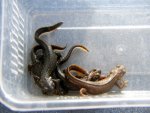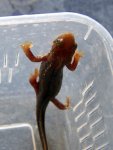End
New member
- Joined
- Jul 21, 2009
- Messages
- 95
- Reaction score
- 2
- Points
- 0
- Country
- Italy
- Display Name
- luca
Hi everyone
Two weeks ago I bought a Cynops Orientalis in a pet shop , i usually buy CB animals , but this newt caught my eyes.
She is really different from my other C.Orientalis wich are just black with red-orange belly , and the structure is different to , maybe is just a normal C.Orientalis (nothing wrong) or could be a different species? she have the same color and belly pattern of my C.Cyanurus but other than that she looks different
anyway , i have some pics
ps: she is healthy and a great eater







Two weeks ago I bought a Cynops Orientalis in a pet shop , i usually buy CB animals , but this newt caught my eyes.
She is really different from my other C.Orientalis wich are just black with red-orange belly , and the structure is different to , maybe is just a normal C.Orientalis (nothing wrong) or could be a different species? she have the same color and belly pattern of my C.Cyanurus but other than that she looks different
anyway , i have some pics
ps: she is healthy and a great eater











